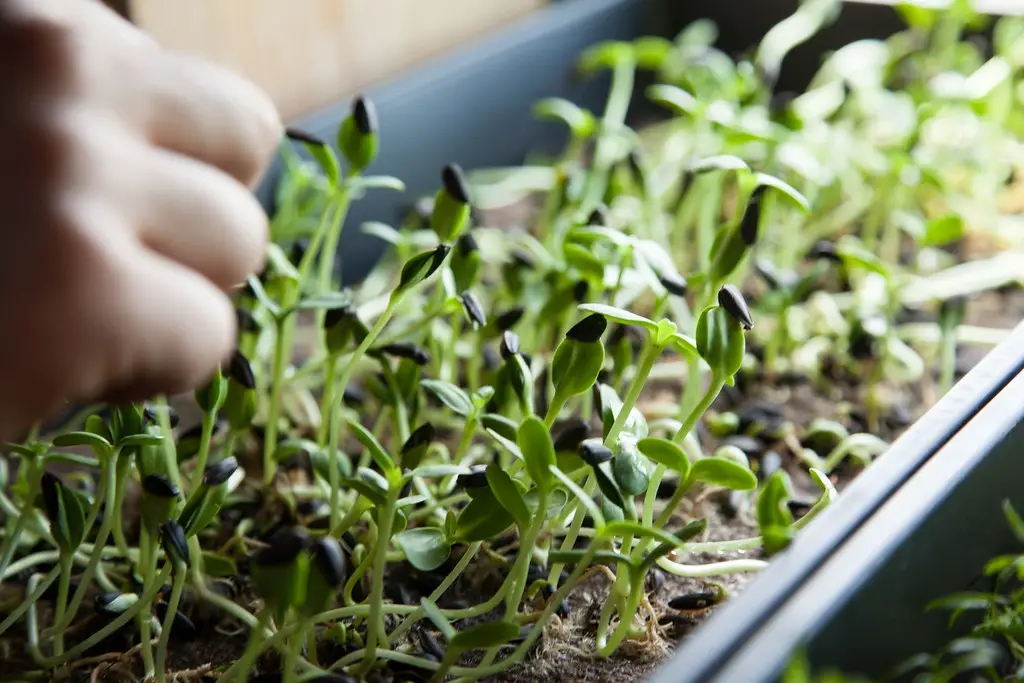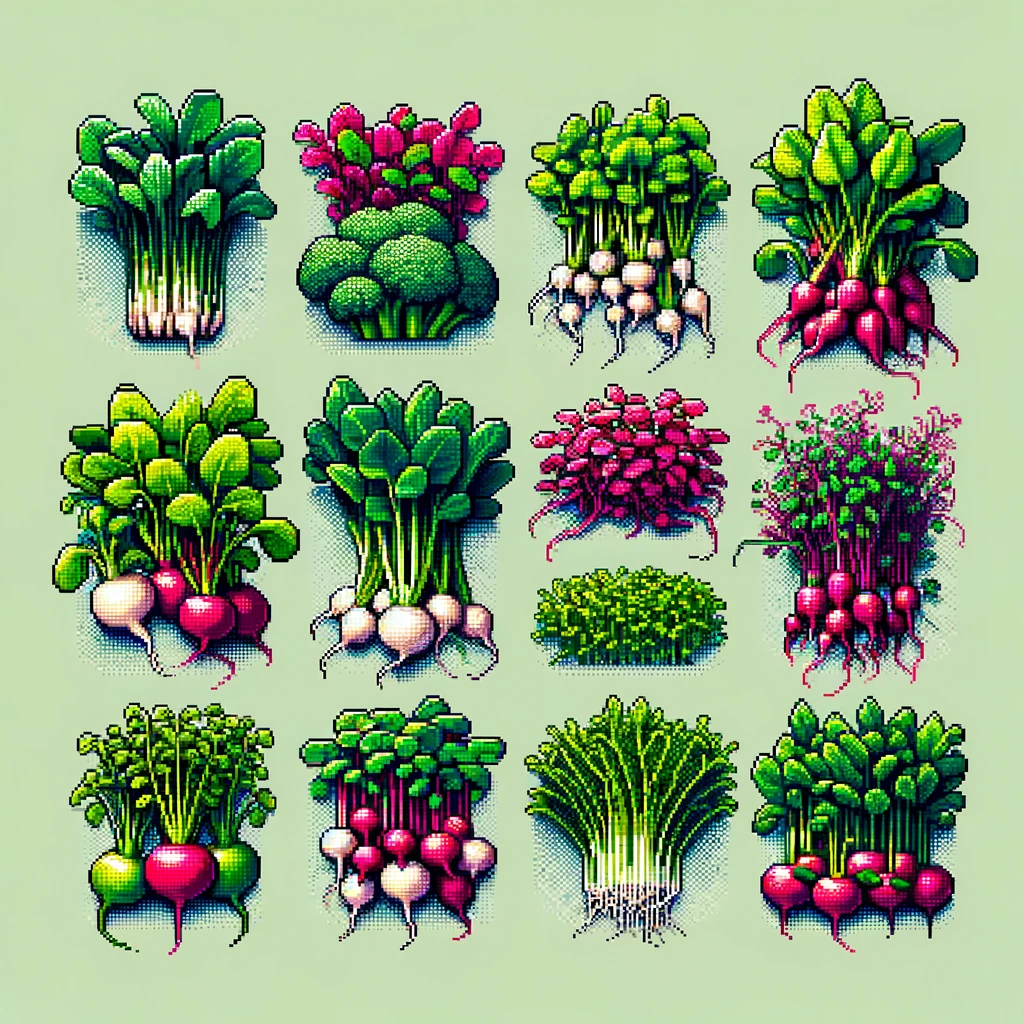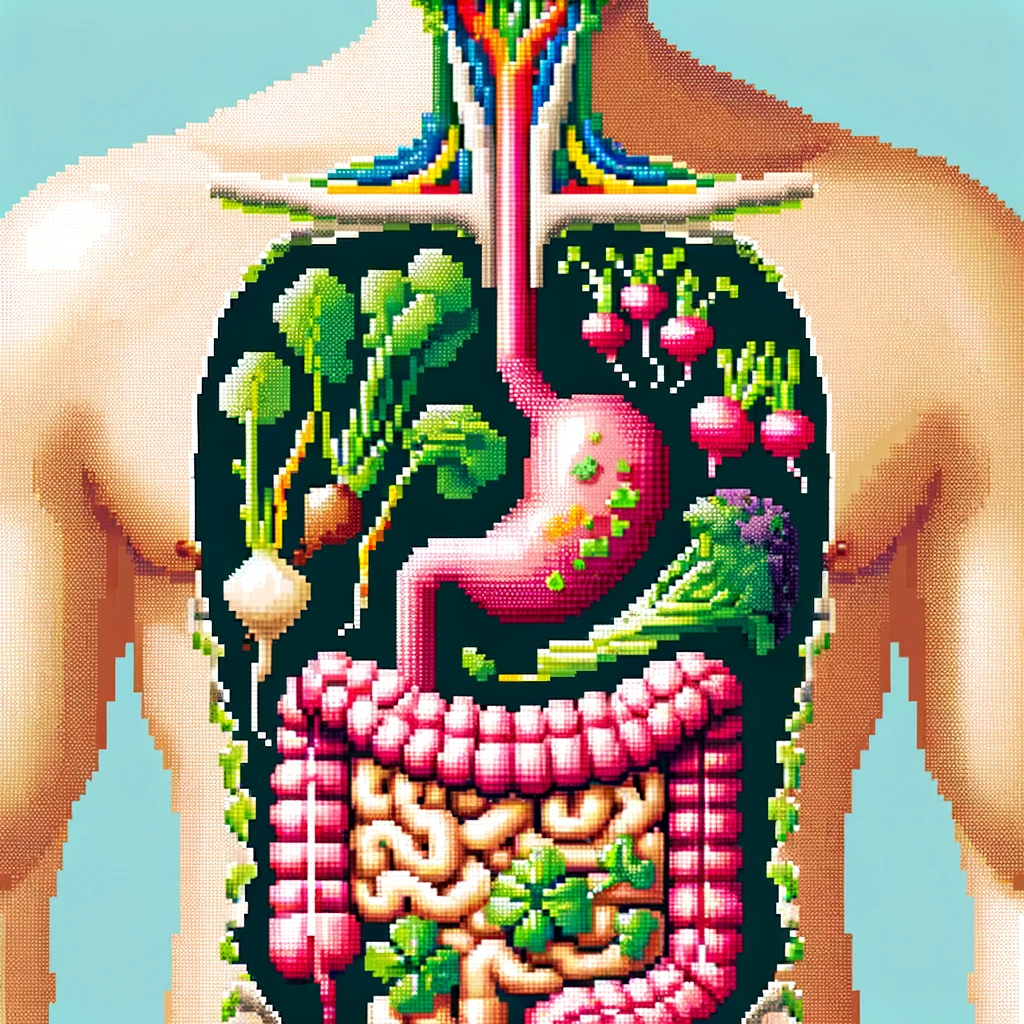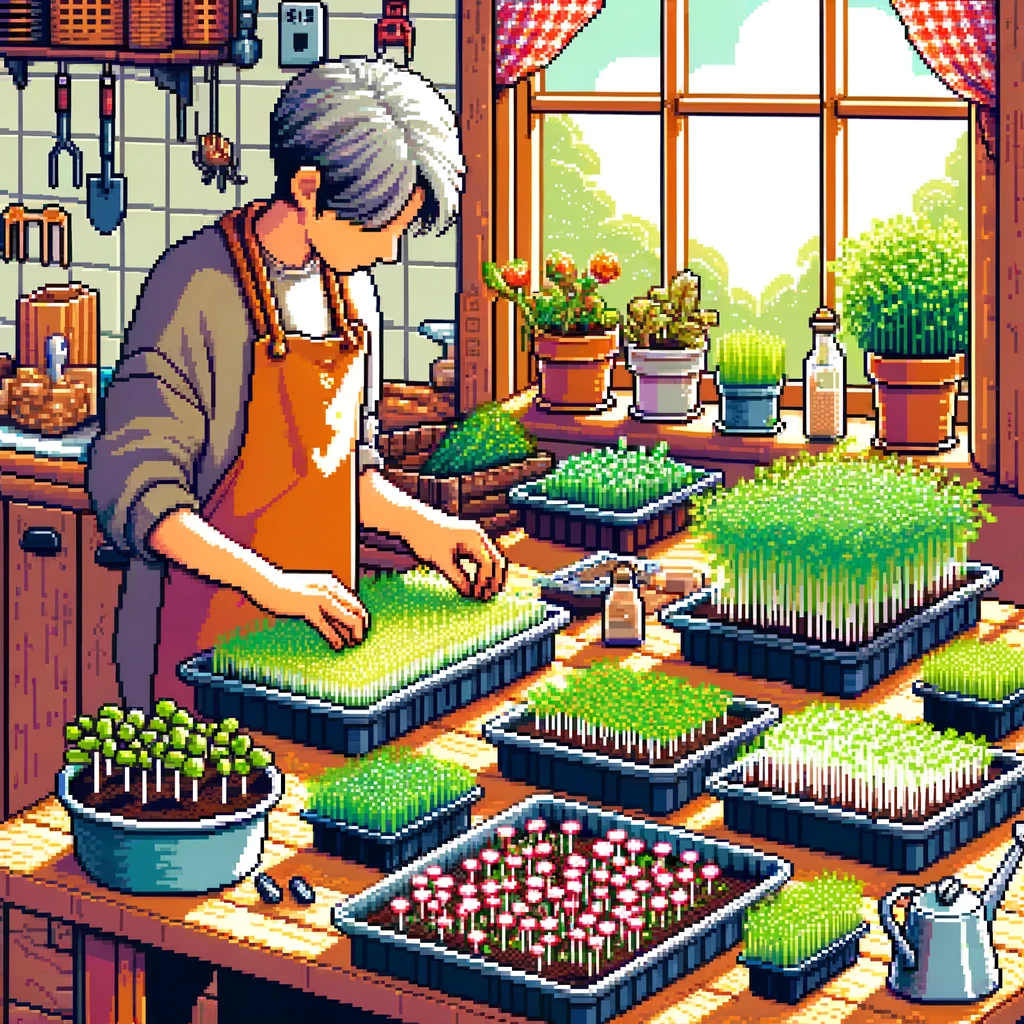
Table of Contents
What are Microgreens?
So what is the big fuss about microgreens? Are they just a fancy hipster fad from recent years that will disappear like any other trend? Are they the superfoods everyone keeps blabbering about? Are they the superhero to our global health and environmental crisis? Several years ago, I heard about this new intriguing term. At first, I thought it was some weird green food created in a lab or some mystifying creature from the ocean (I am talking about you, spirulina). As odd as spirulina is, yet showing evidence of health benefits, and being both micro and green, is not what microgreens are.
Microgreens are much more, well, ordinary foods that you probably consume regularly. Well, if you are accustomed to eating the Standard American Diet, or SAD diet as I like to call it, perhaps not, but after reading this article, you will most definitely want to! Getting back to the microgreens, they are simply carrots, lettuce, broccoli, cabbage, cucumbers, squash, etc. I’m serious; that is what they are. Ok, that is an oversimplification. They are a little bit more exciting than that. The botanical (science of plants) definition of microgreens is “vegetable greens harvested just after the cotyledon leaves have developed.”1 Well, ok, that is nice, but what on earth is a cotyledon?
This is where we will have to define and differentiate some botanical terms. When a plant seed has germinated, you will notice that the first “leaf” appears. This “leaf” is not a true leaf. This seed leaf is called the cotyledon. It is a seed leaf that is sort of like a yolk to the plant embryo inside the seed. It is a nutrient reserve before germination which energizes the plant to have enough energy to germinate. Once germinated, the cotyledon will allow the plant to photosynthesize until the true leaves show up. Pretty interesting, right? To be clear, a plant that only has the cotyledon is considered a sprout. The plant is regarded as a microgreen when the true leaves appear.
So simply put, the microgreens are the older cousins of the sprouts. They are technically both “babies,” but do not get them confused with baby greens either. Baby greens are much more mature and larger than both sprouts and microgreens.
Types of Microgreens and Nutrient Density

Since microgreens are just baby plants of basically anything that you eat or can grow to eat, there are abundant different microgreens to include in your diet. You may be still wondering, though, what is the fuss about it? Can’t I eat the vegetables I’ve been eating my whole life? Well, yes, you can and continue to do so. However, I will discuss the scientific evidence that microgreens are more nutrient-dense than mature plants in this section. So if you are purchasing them, you may be getting more nutrient value for what you are paying for. And if you are growing them yourself, you may save a lot of money while getting more nutrients! I will cover more about growing in a little bit. But first, let us look at the most common types of plants that can be grown as microgreens.
There are several plants that you will be very familiar with. I have grouped them into different families:2,3
- Amaranthaceae family: amaranth, red orach, Swiss chard, beet, spinach, quinoa
- Amaryllidaceae family: garlic, onion, leek
- Apiaceae family: dill, carrot, fennel, celery
- Asteraceae family: lettuce, endive, escarole, chicory, radicchio, sunflower
- Brassicaceae family: cauliflower, broccoli, cabbage, Chinese cabbage, kale, Savoy cabbage, rapini or brassica raab, watercress, mizuna, radish, arugula, mustard, and tatsoi
- Cucurbitaceae family: melon, cucumber, squash
- Fabaceae (legume) family: chickpea, alfalfa, bean, green bean, fenugreek, fava bean, lentil, pea, clover
- Lamiaceae family: Includes most common herbs like mint, basil, rosemary, sage, and oregano.
- Poaceae family: Includes grasses and cereals like barley, corn, rice, oats, and wheatgrass, as well as legumes including beans, chickpeas, and lentils.
Now we will explore the nutritional benefits of microgreens and how they compare with mature plants. Because they are a relatively new commodity, the scientific research about microgreen nutritional quality is also relatively recent. However, the evidence reveals positive, healthy features and health benefits. In a review article from the Journal of Future Foods, several studies mentioned a high concentration of nutrients ranging from antioxidants, vitamins, and minerals.4 For example, the vitamin C content in spinach microgreens is 127% greater than in their mature stage.5 In another study, legume microgreens showed up to 3x higher Zinc content than in their mature stage.6 Zinc acts as an antioxidant cofactor, which means that it activates antioxidants to function in the body. Another example is a study that evaluated all of the major nutrients such as protein, dietary fiber, micronutrients, and minerals of the Brassica microgreens using the Nutrient Quality Score (NQS) rating. The study revealed that “microgreen cauliflower showed six-fold higher NQS than its mature stage.”7
Health Benefits

As mentioned before, research, in general, is limited on microgreens, but so far, the evidence shows exciting ramifications of including them in your diet. The various microgreens nutrient profiles suggest that consuming them should have multiple health benefits. Chronic diseases have been increasing despite the advances in medical technology. Therefore, it would be well to consider lifestyle choices to prevent those diseases from appearing in the first place.
So far, most of the research has either been test tube studies or studies in animals. The studies revealed that microgreens show to control and regulate blood glucose, weight, and fat tissue. These studies lay the foundation to study the potential for prevention and treatment of type 2 diabetes, obesity, and cardiovascular diseases.4 One study looked at bioaccessibility, or how easily the nutrients are absorbed in the body. It showed that the highest percentage of nutrients that can be released were from kohlrabi and kale microgreens. These features are significant because, after digestion, their nutrients can provide anti-inflammatory, anticancer, and anti-diabetic activities.8
In another study, treating colon cell tumors with broccoli, kale, mustard, and radish microgreens significantly slowed the growth of the cancerous cells. With their higher vitamin C and antioxidant levels, radish microgreens showed to be a more potent cancer cell suppressor than the rest of the microgreens.9 Fenugreek microgreen extract showed to decrease in the enzyme activity responsible for the breakdown of starches into glucose, indicating the potential for regulating blood glucose levels.10 In other studies, there is evidence of red cabbage microgreens controlling cholesterol levels and decreased inflammatory markers in mice fed a high-fat diet.11
How specific nutrients like vitamins, minerals, and antioxidants affect the human body are well understood. Microgreens are rich in those nutrients, so from that standpoint, microgreens are super healthy foods that you should include in your diet! The following steps in the research phase of health benefits would be conducting pre-clinical and clinical trials to determine more beneficial features of microgreens on human health.
How to Grow Microgreens

You can purchase microgreens at any health food store near you. Sometimes they even sell them at Wal-Mart and big grocery stores too. However, they can be pretty pricey as industries market them as organic and healthy. It would be more economical to grow your own, as it is an inexpensive way to have a continuous supply of fresh greens. In general, growing microgreens is simple enough that you do not need any experience at all. It is straightforward to learn, it’s fun, and you will be able to show off to your friends and family that you are on your way to becoming self-sustainable.
The advantages of growing microgreens yourself are that it is easy to grow in a limited amount of space. At most, the time to grow them is no longer than 2-3 weeks. That means if there are mistakes when growing them, you do not have to wait long periods or the following season. Starting over is straightforward, and little resource is lost. As we saw in previous sections, they are incredibly healthy for your health as they are highly nutritious. Another great advantage is that there are no climate restrictions since you can grow them indoors with no problem. If you are business-minded, growing microgreens for profit is something to consider since healthy living is rising due to the global health and environmental crises we are experiencing today.
We saw several different plants that you can grow as microgreens. It is worthy to note that some plants are easier to grow, and others are more challenging. Those that are easier to grow and that you can quickly harvest are as follows: arugula, sunflower, kale, radish, broccoli, mustard, bok choy, komatsuna, cress, lettuce, red-veined sorrel, wheatgrass, and peas. Microgreens that are more challenging to grow are amaranth, beets, Swiss chard, cilantro, basil, dill, carrots, scallions, and purslane.
To start growing microgreens, you will need some equipment. I will now discuss what you need to grow your upcoming delectable foods!
Seeds
Seeds are obviously the first on the list. Make sure to choose from the easy to grow list above so you can get a good idea of what it is like to grow microgreens. I recommend starting with broccoli or kale since dark leafy greens are more nutrient-dense than any other food. Once you decide which ones you want to begin with, you will have to buy the seeds. Some websites sell seeds specifically for harvesting microgreens. I will link those in the Additional Resources section. Otherwise, you can choose to go to your local garden store and purchase seeds there. I will provide a link to a cheat sheet that shows the necessary growing information, such as how much time it takes for specific plants to reach the point of harvest.
Growing media
The simplest growing medium to use is a seed starting mix or a germination mix that you can purchase at your local garden store. These soil mixes contain peat moss and vermiculite/perlite, which will provide proper soil aeration and water retention. If you read our biochar article, it wouldn’t hurt to put a couple of teaspoons of biochar into your mix to retain nutrients for a future set of plants. You can also use coco coir, an eco-friendlier option than peat moss.
Trays
You will need some trays to place your soil. The most common size to use for microgreens is 10x20x1 inch trays. This size is perfect since the plant roots will not grow that much. Ensure that the trays have holes in the bottom to facilitate proper water draining.
Lights
Natural sunlight is the best when growing microgreens since it is available every day at no cost! Other options are to use artificial lights such as TL tubes or LEDs. If you choose to use artificial lights, you will want blue light since the blue spectrum promotes growth. Make sure to set a timer for 16 hours to encourage maximum growth of your microgreens. Perhaps get those plugin outlets with a 24hr timer on them so you can just set and forget.
Misting Bottle
At first, you do not want to water your soil with a hose or cup because the seeds might float up. Instead, a misting bottle will be best during the germination stage. Once germinated, you can use a cup to water the soil.
Step by Step Instructions
When you get all the materials and supplies you need, starting to plant is simple. If you follow these simple steps, you will begin to produce healthy greens in no time!
1. Secure a reasonable location
Pick a spot where you will have either a good amount of sunlight or a place you can set up artificial lighting for your plants.
2. Prepare your trays
Grab your 10x20x1 inch trays, give them a quick rinse, and dry them off. Fill them with the soil you chose to about ¾ inch. Then level out the soil with a piece of cardboard or something similar.
3. Sow seeds
It may be good to soak the seeds a few hours before sowing, especially larger seeds with rigid hulls. Otherwise, begin to sow the seeds evenly over the entire surface of the tray using a spice shaker (using a spice shaker will make things easier, trust me). Then cover the seeds with an additional ¼ inch to complete the 1-inch of your tray height.
4. Press the soil
Pressing the soil is a good gardening habit since it will facilitate good soil contact and moisture absorption.
5. Cover, water as needed, and wait
Covering is not so significant, but you want to ensure enough water throughout the germination phase. Sometimes a plastic wrap will be good until germination. If your trays are uncovered, make sure to mist at least once a day with your mist bottle. Keep your seeds moist but not too wet. Once the seeds have sprouted, I recommend spraying once or twice a day.
6. Harvest
Once your plants have produced true leaves, you are ready to harvest and eat them! To harvest, snip the stems just above the soil line with scissors. Rinse them and dry them on a paper towel. You can now put them on salads, sandwiches, or any other dishes you prefer!
Additional Resources
Websites that sell seeds:
www.trueleafmarket.com
www.highmowingseeds.com
www.johnnyseeds.com
The Ultimate Microgreen Cheat Sheet
https://www.bootstrapfarmer.com/blogs/microgreens/the-ultimate-microgreen-cheat-sheet
Frequently Asked Questions (FAQs) about Microgreens
1. What are Microgreens?
- Microgreens are young vegetable greens that are approximately 1–3 inches tall. They are the stage between sprouts and baby leaf vegetables and are known for their nutritional value.
2. How are Microgreens Different from Sprouts?
- Microgreens differ from sprouts in that they are grown in soil and need sunlight, and only the above-ground parts are eaten. In contrast, sprouts are grown without soil and harvested with the roots attached.
3. What Nutrients are Found in Microgreens?
- Microgreens are rich in various nutrients including vitamins, minerals, and antioxidants. They often contain higher nutrient levels than the same quantity of mature vegetables.
4. Are Microgreens Easy to Grow at Home?
- Yes, microgreens are relatively easy to grow at home. They require minimal space and can be grown in a variety of containers, making them ideal for urban gardening.
5. How Long Does It Take to Grow Microgreens?
- Generally, microgreens can be harvested within 1 to 3 weeks after planting, depending on the variety.
References
1. https://en.wikipedia.org/wiki/Microgreen
2. Renna, M., Di Gioia, F., Leoni, B., Mininni, C., & Santamaria, P. (2016). Culinary Assessment of Self-Produced Microgreens as Basic Ingredients in Sweet and Savory Dishes. Journal of Culinary Science & Technology, 15(2), 126–142. doi:10.1080/15428052.2016.1225534
3. https://grocycle.com/types-of-microgreens/
4. Y. Zhang, Z. Xiao, et. al., Nutritional quality and health benefits of microgreens, a crop of modern agriculture, Journal of Future Foods, 1(1), 58-66.
https://doi.org/10.1016/j.jfutfo.2021.07.001.
5. M.D. Ghoora, D.R. Babu, N. Srividya, Nutrient composition, oxalate content and nutritional ranking of ten culinary microgreens, J. Food Compost. Anal. 91 (2020) 103495. https://doi.org/10.1016/j.jfca.2020.103495.
6. B. Butkutė, L. Taujenis, E. Norkevičienė, Small-seeded legumes as a novel food source. variation of nutritional, mineral and phytochemical profiles in the chain: raw seeds-sprouted seeds-microgreens, Molecules 24 (2018) 133. https://doi.org/10.3390/molecules24010133.
7. M. Renna, A.M. Stellacci, F. Corbo, et al., The use of a nutrient quality score is effective to assess the overall nutritional value of three Brassica microgreens, Foods 9 (2020). https://doi.org/10.3390/foods9091226.
8. T.N. Le, C.H. Chiu, P.C. Hsieh, Bioactive compounds and bioactivities of Brassica oleracea L. var. italica sprouts and microgreens: an updated overview from a nutraceutical perspective, Plants 9 (2020) 946. https://doi.org/10.3390/plants9080946.
9. B.d.l. Fuente, G. López-García, V. Máñez, et al., Antiproliferative effect of bioaccessible fractions of four Brassicaceae microgreens on human colon cancer cells linked to their phytochemical composition, Antioxidants 9 (2020) 368. https://doi.org/10.3390/antiox9050368.
10. S. Wadhawan, J. Tripathi, S. Gautam, In vitro regulation of enzymatic release of glucose and its uptake by Fenugreek microgreen and Mint leaf extract, Int. J. Food Sci. Technol. 53 (2018) 320-326. https://doi.org/10.1111/ijfs.13588.11. H. Huang, X. Jiang, Z. Xiao, et al., Red cabbage microgreens lower circulating low-density lipoprotein (LDL), liver cholesterol, and inflammatory cytokines in mice fed a high-fat diet, J. Agric. Food Chem. 64 (2016) 9161-9171. https://doi.org/10.1021/acs.jafc.6b03805.
